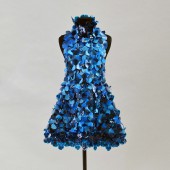A Lenticular Mini-Dress Garment by Kyung-Hee Choi |
Home > Winners > #71517 |
 |
|
||||
| DESIGN DETAILS | |||||
| DESIGN NAME: A Lenticular Mini-Dress PRIMARY FUNCTION: Garment INSPIRATION: Lenticular printing is a technology in which lenticular lenses for 3D displays are used to produce printed images with the ability to change as the image is viewed from different angles. The plankton-shaped modules with flexible blue/black lenticular fabrics were joined without sewing to show the aquatic color changes of the deep sea and also represent a school of microscopic plankton organisms. UNIQUE PROPERTIES / PROJECT DESCRIPTION: Employing a dynamic impression of lenticular fabric sheets, this work aims to explore the multiple variableness of colors and textile motifs in a mini-dress with the theme of plankton, the organic creatures in the ocean. The main focus in the design methodology was to create a new module-based textile design with iridescent color changes. For this, textile motifs with two different shapes from a plankton image were designed, and then an origami module was created from the outline of the motif. OPERATION / FLOW / INTERACTION: For interacting with the lenticular dress, the author suggest viewers watching it from different angles. PROJECT DURATION AND LOCATION: The project started in April 2018 in USA and finished in June 2018. FITS BEST INTO CATEGORY: Fashion, Apparel and Garment Design |
PRODUCTION / REALIZATION TECHNOLOGY: For the variations of the design, the plankton motifs, printed on clear fluorescent blue vinyl, were placed randomly on the skirt part and also regularly on both the neckline and the hemline with the modular textile. To emphasize the modular technique with the 3D lenticular effect, a simple A-line mini-dress with a halter neck was developed, and iridescent colors based on blue/black were used for the dress. SPECIFICATIONS / TECHNICAL PROPERTIES: Bust 33”, Waist 25”, Height 35”. TAGS: Lenticular, Module, Plankton, 3D motion RESEARCH ABSTRACT: Digital technology has created innumerable possibilities to apply new media based on three-dimensional motion effects to fashion design with interactive visual prospects. Lenticular printing is a technology in which lenticular lenses for 3D displays are used to produce printed images with an illusion of depth, or the ability to change or move as the image is viewed from different angles. Employing a dynamic impression of lenticular fabric sheets, this work aims to explore the multiple variableness of colors and textile motifs in a mini-dress with the theme of plankton, the organic creatures in the ocean. The main focus in the design methodology was to create a new module-based textile design with iridescent color changes. For this, textile motifs with two different shapes from a plankton image were designed, and then an origami module was created from the outline of the motif. Thus, the plankton-shaped modules with flexible blue/black lenticular fabrics were connected and joined without sewing to show the aquatic color changes of the deep sea and also represent a school of microscopic plankton organisms. For the variations of the design, the plankton motifs, printed on clear fluorescent blue vinyl, were placed randomly on the skirt part and also regularly on both the neckline and the hemline with the modular textile. To emphasize the modular technique with the 3D lenticular effect, a simple A-line mini-dress with a halter neck was developed, and iridescent colors based on blue/black were used for the dress. The work process and techniques are as follows: 1. Two textile motifs were developed with a plankton image using Photoshop, Illustrator, and Aftereffect computer software. In particular, the motifs of fluorescent colors represent the dynamic contraction and expansion of the organisms. 2. A hexagon-based module was created and cut out from the outline of plankton motifs. To show the multiple color changes of the ocean, blue/black lenticular sheets were used for the module (figure 2). 3. The textile motifs were printed on clear vinyl and also attached to blue-colored vinyl to present a feeling of water. Then, the edge of the printed motifs was cut out. 4. Each lenticular module was joined together without sewing to make a bodice with a halter neck. 5. The modules with plankton motifs were connected with lenticular modules to make a flared skirt. Finally, an A-line lenticular mini-dress was completed. 6. The fluorescent blue modules with plankton motifs were added to the neckline and the hemline of the dress. The lenticular optical process presents diverse potential uses in fashion design by transforming static images into dynamic motions, including flip and animation effects. With the hologram displays of lenticular fabrics, the lenticular modular dress also provides an effective technique for textile development. CHALLENGE: It was challenging to find out a proper material to realize dynamic color and pattern changes. But developing an optimal material is ongoing still ongoing. ADDED DATE: 2018-09-29 11:32:10 TEAM MEMBERS (1) : IMAGE CREDITS: BYUN SOON CHOEL |
||||
| Visit the following page to learn more: https://samchi28.wixsite.com/mysite | |||||
| AWARD DETAILS | |
 |
A Lenticular Mini-Dress Garment by Kyung-Hee Choi is Winner in Fashion, Apparel and Garment Design Category, 2018 - 2019.· Press Members: Login or Register to request an exclusive interview with Kyung-Hee Choi. · Click here to register inorder to view the profile and other works by Kyung-Hee Choi. |
| SOCIAL |
| + Add to Likes / Favorites | Send to My Email | Comment | Testimonials | View Press-Release | Press Kit | Translations |







